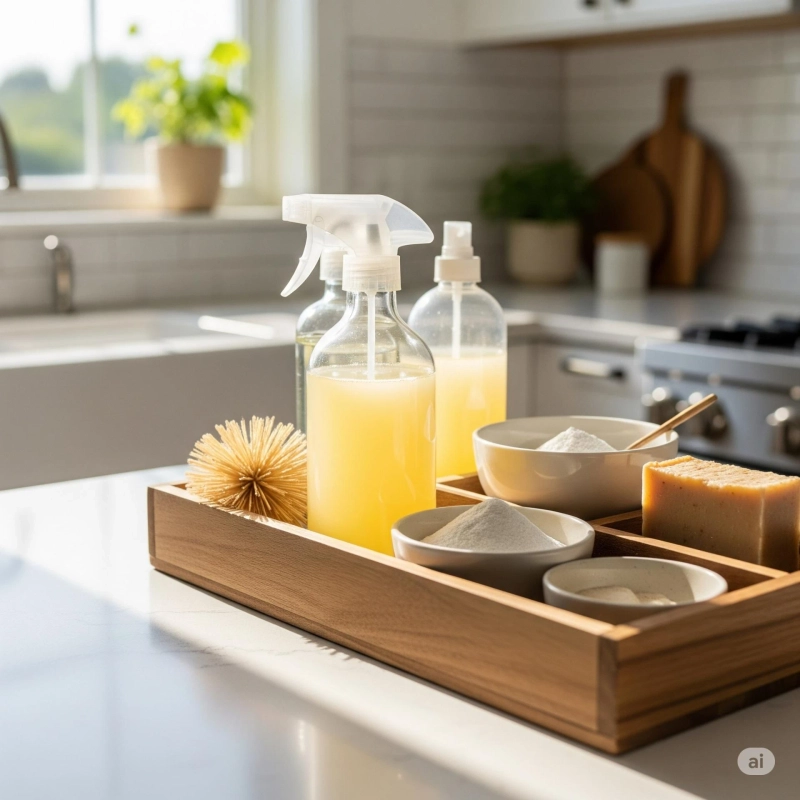In an age where health and environmental consciousness are paramount, many homeowners are making the switch to non-toxic cleaning products. Gone are the days when a "clean" smell meant a strong chemical odor. Today, it's about achieving sparkling results while safeguarding your family's well-being and protecting our planet. But with so many options available, how do you choose the best natural cleaning products for every room in your home?
This comprehensive guide will demystify the world of non-toxic cleaning, highlighting top picks and DIY solutions that are both effective and genuinely safe. Get ready to transform your cleaning routine and embrace a truly healthy home!
Why Go Non-Toxic? The Hidden Dangers of Conventional Cleaners
Before we dive into the good stuff, let's understand why making this switch is so important. Traditional cleaning products often contain a cocktail of harsh chemicals linked to a range of health issues and environmental concerns, including:
- Respiratory Problems: Ingredients like ammonia and phthalates can trigger asthma, allergies, and other breathing difficulties.
- Skin Irritation: Bleach, strong acids, and synthetic fragrances can cause rashes, eczema, and burns.
- Hormone Disruption: Phthalates, often hidden in "fragrance," are endocrine disruptors.
- Environmental Pollution: Many chemicals end up in our waterways, harming aquatic life and ecosystems.
- Indoor Air Quality: VOCs (Volatile Organic Compounds) released by conventional cleaners linger in your home, impacting air quality.
By opting for natural and safe alternatives, you significantly reduce your exposure to these harmful substances, creating a healthier living space for everyone, including children and pets.
Your Non-Toxic Arsenal: Key Ingredients to Look For (and Avoid!)
Navigating product labels can be tricky. Here's a quick cheat sheet for what to embrace and what to steer clear of:
Embrace These Natural Powerhouses:
- White Vinegar: A natural disinfectant, deodorizer, and grease cutter. Perfect for all-purpose cleaning, glass, and hard water stains.
- Baking Soda (Sodium Bicarbonate): A mild abrasive, deodorizer, and stain remover. Great for scrubbing, absorbing odors, and neutralizing acids.
- Lemon Juice: Acidic, antibacterial, and provides a fresh scent. Excellent for cutting grease, brightening surfaces, and tackling mildew.
- Castile Soap: A concentrated, plant-based soap for gentle yet effective cleaning. Versatile for dishes, floors, and even laundry.
- Essential Oils (Tea Tree, Lavender, Lemon, Eucalyptus): Offer natural antibacterial, antiviral, and antifungal properties, plus delightful aromas. Always use sparingly and dilute properly.
- Hydrogen Peroxide: A natural bleach alternative and disinfectant.
Avoid These Harmful Chemicals:
- Phthalates (often hidden in "fragrance")
- Chlorine Bleach
- Ammonia
- Formaldehyde
- Parabens
- Phosphates
- Synthetic Fragrances & Dyes
- Triclosan
Look for Certifications: When buying pre-made products, keep an eye out for certifications like EWG Verified, USDA Organic, Leaping Bunny (cruelty-free), and EcoLogo. These indicate a commitment to safety and sustainability.
Room by Room: Best Non-Toxic Cleaning Products
Let's break down the best natural and safe solutions for every area of your home:
1. Kitchen: The Heart of Your Home, Naturally Clean
The kitchen is where food is prepared, so non-toxic cleaning is crucial here.
- All-Purpose Cleaner:
- DIY: Mix equal parts white vinegar and water in a spray bottle. Add 10-15 drops of lemon or orange essential oil for a fresh scent.
- Store-Bought: Look for brands like Seventh Generation All-Purpose Cleaner, Mrs. Meyer's Clean Day Multi-Surface Everyday Cleaner, or Method All-Purpose Cleaner.
- Dish Soap:
- DIY: Combine liquid Castile soap with water and a few drops of lemon essential oil.
- Store-Bought: Eco-friendly options include Seventh Generation Dish Liquid, Method Dish Soap, or ECOS Dishmate Dish Liquid.
- Oven Cleaner:
- DIY: Make a thick paste with baking soda and water. Apply to the oven, let sit overnight, then scrub and wipe clean. For tough spots, add a little vinegar.
- Countertops:
- DIY: Use your vinegar-based all-purpose cleaner. For granite or marble, which can be etched by vinegar, use a solution of warm water and a few drops of Castile soap.
- Floors (Tile, Linoleum):
- DIY: Mop with a mixture of 1/2 cup white vinegar per gallon of warm water, plus a few drops of essential oil.
- Store-Bought: ECOS Floor Cleaner or Better Life Floor Cleaner.
2. Bathroom: Sparkling Clean, Without the Fumes
Bathrooms often require powerful cleaning, but you don't need harsh chemicals to tackle grime and mildew.
- Toilet Bowl Cleaner:
- DIY: Sprinkle 1/2 cup baking soda into the bowl, let sit for 15-30 minutes, then scrub with a toilet brush and flush. For extra power, spray with white vinegar after adding baking soda, let it fizz, then scrub.
- Store-Bought: Seventh Generation Toilet Bowl Cleaner or ECOS Toilet Bowl Cleaner.
- Shower & Tub Scrubber:
- DIY: Create a paste with baking soda and a small amount of liquid Castile soap or hydrogen peroxide. Apply, scrub with a sponge or brush, and rinse.
- Store-Bought: The Honest Company Bathroom Cleaner or BioKleen Bac-Out Bathroom Cleaner.
- Glass & Mirrors:
- DIY: Mix equal parts white vinegar and water in a spray bottle. Wipe with a microfiber cloth for streak-free shine.
- Grout Cleaner:
- DIY: A baking soda and hydrogen peroxide paste works wonders. Apply, let sit for 10-15 minutes, then scrub with an old toothbrush.
3. Living Areas & Bedrooms: Fresh and Dust-Free
These are the rooms where you relax and breathe deeply, making non-toxic choices even more critical.
- Dusting Spray:
- DIY: Combine 1 cup water, 1/4 cup white vinegar, 2 tablespoons olive oil (for shine on wood), and 10-15 drops of lemon or lavender essential oil in a spray bottle. Shake well before each use.
- Window Cleaner:
- DIY: Same as glass & mirrors in the bathroom (equal parts white vinegar and water).
- Carpet Freshener:
- DIY: Sprinkle baking soda liberally over carpets, let sit for at least 30 minutes (or overnight for strong odors), then vacuum thoroughly. Add a few drops of essential oil to the baking soda for added fragrance.
- Air Freshener:
- DIY: Avoid synthetic aerosol sprays. Instead, diffuse essential oils, simmer citrus peels and spices on the stovetop, or simply open windows for fresh air.
- Store-Bought: Brands offering natural air fresheners often use essential oils and plant-based ingredients. Look for products free of phthalates and synthetic fragrances.
4. Laundry Room: Gentle on Clothes, Kind to Skin
Laundry detergents are often loaded with harsh chemicals and artificial fragrances that can irritate skin and linger on clothes.
- Laundry Detergent:
- DIY: Many recipes exist online using ingredients like borax, washing soda, and soap flakes.
- Store-Bought: Seventh Generation Laundry Detergent, Molly's Suds Laundry Powder, or ECOS Liquid Laundry Detergent. These are often free of dyes, fragrances, and phosphates.
- Fabric Softener/Dryer Sheets:
- DIY: Add 1/2 cup white vinegar to the rinse cycle (it won't leave a vinegar smell!). For dryer sheets, add a few drops of essential oil to wool dryer balls.
- Store-Bought: Wool dryer balls (reusable!) or plant-based fabric softeners from brands like Seventh Generation.
Making the Switch: Quick Tips for Success
- Start Small: You don't have to overhaul everything at once. Begin by replacing one or two frequently used products.
- Read Labels Diligently: Be a smart consumer. "Greenwashing" is common, so always check the ingredient list, not just the marketing claims.
- Invest in Quality Tools: Microfiber cloths, reusable spray bottles, and scrub brushes will be your best friends on this journey.
- Patch Test: Especially with DIY solutions, always test on an inconspicuous area first to ensure it won't damage surfaces.
- Educate Yourself: Continuously learn about new natural ingredients and sustainable practices.
Embracing natural and non-toxic cleaning products is more than just a trend; it's a commitment to a healthier home and a more sustainable lifestyle. By choosing these safe and effective alternatives, you're not only creating a cleaner living environment but also contributing to a cleaner planet. So, ditch the harsh chemicals and discover the power of nature's cleaning solutions – for every room, every day.


